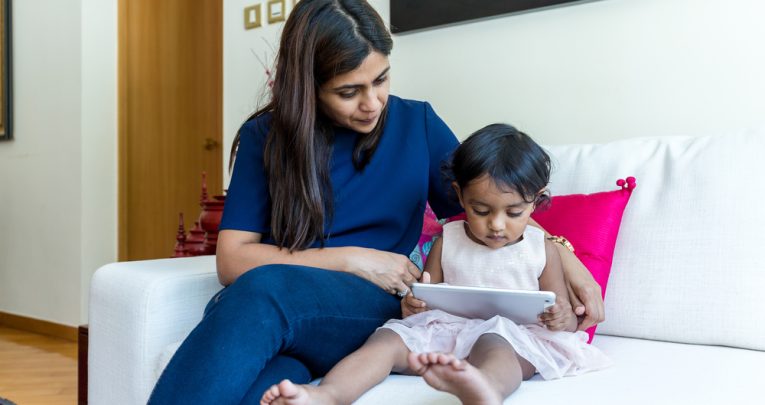Online Parental Engagement – How It Can Help, And How To Get Started

Are you ready to share learning journeys with parents electronically? Sarah Steel explains what Early Years settings and managers stand to gain from doing so…

- by Sarah Steel

Venture to any of the many nursery trade shows this year, and you will see a number of suppliers demonstrating e-learning journey software – an alternative way of recording children’s development, and a replacement for the scrapbook-style learning journeys that most settings and childminders use as a record to share with parents.
There are now several such products on the market running on tablets, PCs and laptops, which allow practitioners to capture moments, carry out observations and link them to the EYFS.
Why use them?
At The Old Station Nursery we introduced e-learning journeys about two years ago, and since then have trialled three different systems. They all work on the same basis – staff load children’s profiles onto the system via a tablet or PC, and then use tablets to take photos or videos of their key children at play.
This is then linked to a development statement, and you effectively ‘tag’ that child, so that your observation is filed in its own area. Parents can log on to see the observation, what their children have been doing and the progress they’re making.
We thought they would save staff time by avoiding the need to cut out photos and stick them into scrapbooks. In reality, I’m not sure they do – but they are certainly much more visual, utilising high-quality digital images and video, plus sound clips, which are better for parents.
The benefits
We’ve found that when managed well, e-learning journeys are a great way of building parent partnerships. Many parents are busy, and at pick-up time it’s hard to convey all that you’ve done with a child during the day. Yet when they log on to the system, often during the evening, they can follow their child’s progress at their leisure. Anxious parents with new starters can also look during the day to see if any observations have been made or photos posted. Parents can opt to receive email notifications whenever a new entry is made on their child’s learning journey.
It can really help practitioners with planning if parents engage with the system. If parents can record their weekend activities, then it’s easy for a practitioner to check the child’s learning journey on Monday morning and introduce a relevant topic at circle time. Aware that Johnny visited the zoo, for example, the preschool leader might ask if anyone has seen any interesting animals over the weekend, and open a dialogue that could lead to a really enjoyable activity.
E-learning journeys can also be shared between parents and family members elsewhere in the country or overseas – something that we’ve found to be particularly good for Forces families. Those posted away from home can log on to the system and keep up to date with hardly any effort at all.
When a child leaves nursery, their learning journey is stored on a CD or USB stick and can be optionally printed, giving parents a record that they can keep and show to their child’s new schoolteacher.
The challenges
Where technology is involved, however, it will always cause a challenge for some. This applies equally to staff and parents – we found that some staff adapted quickly, while others found it harder to get used to the processes involved. However, with appropriate support and monitoring and a designated ‘lead’ for the system, everyone got there in the end.
Where parents were concerned, some immediately embraced the system while others took longer to engage. We found that holding drop-in sessions in the nursery office, where the manager helped parents set the app up on their smartphones and got them going on the system, led to much higher levels of involvement.
Like all systems within a setting, e-learning journeys need to be properly managed. Managers have a range of options available to them – he or she can proofread some or all observations before they reach parents; view reports to see how the system is being used by different staff; and even track the progress of children across each room and the whole nursery at the press of a button. The latter can be excellent for showing an Ofsted inspector how progress is being made at your setting.
However, it will take a bit of time and thought to get the system running how you want it. Each team will need to agree how they are going to make it work for them. There are also clearly costs involved, but most systems will be paid for via a monthly or annual fee, and suppliers offer the option to buy tablets through them as well.
We have tried to maintain flexibility and not commit to one system with a large purchase or long commitment, as systems are developing fast and the cost of tablets has also come down considerably.
The future?
Finally, you will need a good Wi-Fi signal throughout your setting, since the number of tablets you use and the size/layout of your premises might make it difficult to access the online system everywhere you need to. Some systems will automatically save observation data when you move out of Wi-Fi range, and then reconnect and upload it once you’ve picked up the signal again, which is a good feature to look out for.
Having now made the move to e-learning journeys, we’d never go back to paper – but we’re continuing to review new developments in the marketplace and are looking to see how we can link e-learning journeys with other software in future, so that we’re not operating more systems than necessary.
Fortunately, there seems to be an increasing awareness of how technology can benefit practitioners in the early years sector, so I am optimistic that the suppliers will continue to rise to the challenge.
Sarah Steel is managing director of The Old Station Nursery; for more information, visit theoldstationnursery.co.uk or its Facebook page
Do You YouTube?
Caron Moseley explains how Kiddi Caru uses online video to engage with mums and dads…
One of our specific objectives in launching our own YouTube channel was to help support parental engagement. It has extended our presence on social media and directs viewers back to our website so they can make contact with us.
Our videos illustrate activities taking place in our nurseries and incorporate on-screen captions, explaining to viewers what children gain from them. Future presentations will suggest ideas for parents to try at home, such as ‘Sing and Sign’.
Managers can sometimes get hung up on creating an ‘interesting’ story, and worry that if the setting hasn’t held a ‘special event’ of some sort, then the story, photos or videos won’t make for good content. In our experience, parents just like to see what their children have been doing as part of their everyday lives – whatever that might be!
Caron Moseley is marketing manager at Kiddi Caru; for more information, visit www.kiddicaru.com or follow @Kiddicaru











